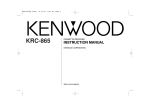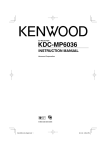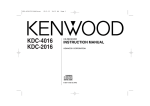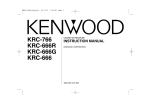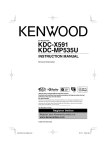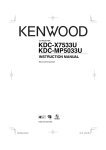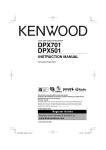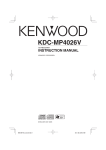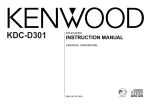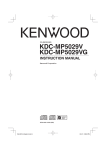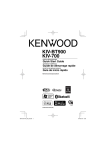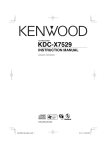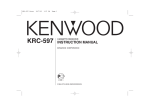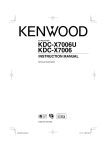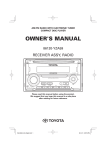Download Kenwood KDC-MP5029 User's Manual
Transcript
CD-RECEIVER
KDC-MP6029
KDC-MP5029
INSTRUCTION MANUAL
© B64-2950-00/00 (MW)
B64-2950-00_English.indd 1
04.11.9 0:52:48 PM
Contents
Safety precautions
3
Notes
4
About CDs
5
About AAC,MP3 and WMA
6
General features
7
Power
Selecting the Source
Volume
Attenuator
System Q
Audio Control
Audio Setup
Speaker Setting
Subwoofer Output
Switching Display
Dimmer Control
Theft Deterrent Faceplate
TEL Mute
Tuner & TV features
Menu system
19
Menu System
Security Code
Touch Sensor Tone
Manual Clock Adjustment
DSI (Disabled System Indicator)
Selectable Illumination
Dimmer
Built-in Amp Setting
AMP Control
CRSC (Clean Reception System Circuit)
Auxiliary Input Display Setting
Text Scroll
CD Read Setting
Basic Operations of remote
23
Accessories/ Installation Procedure 25
12
Tuning
Tuning Mode
Direct Access Tuning
Station Preset Memory
Auto Memory Entry
Preset Tuning
Frequency Step Setting
TV Tuning
TV channel Preset Memory
Preset TV Tuning
Direct TV Tuning
Connecting Wires to Terminals
26
Installation
28
Removing the Unit
30
Troubleshooting Guide
31
Specifications
34
CD/Audio file/External disc control
features
15
Playing CD & Audio file
Playing External Disc
Fast Forwarding and Reversing
Track/File Search
Disc Search / Folder Search
Direct Track / File Search
Direct Disc Search
Track/File/Disc/Folder Repeat
Scan Play
Random Play
Magazine Random Play
Folder Select
Text/Title Scroll
2 |
English
B64-2950-00_English.indd 2
04.11.9 0:52:48 PM
Safety precautions
2WARNING
To prevent injury or fire, take the
following precautions:
• To prevent a short circuit, never put or leave any
metallic objects (such as coins or metal tools)
inside the unit.
Attach the panel while you are on the
vehicle
The panel lock arm will be appeared when the
panel is removed. Therefore, the panel must be
attached during the driving.
2CAUTION
To prevent damage to the machine, take
the following precautions:
• Make sure to ground the unit to a negative 12V
DC power supply.
• Do not install the unit in a spot exposed to direct
sunlight or excessive heat or humidity. Also avoid
places with too much dust or the possibility of
water splashing.
• Do not set the removed faceplate or the faceplate
case in areas exposed to direct sunlight, excessive
heat or humidity. Also avoid places with too much
dust or the possibility of water splashing.
• To prevent deterioration, do not touch the
terminals of the unit or faceplate with your
fingers.
• Do not subject the faceplate to excessive shock,
as it is a piece of precision equipment.
• When replacing a fuse, only use a new one with
the prescribed rating. Using a fuse with the wrong
rating may cause your unit to malfunction.
• Do not apply excessive force to the open
faceplate or place objects on it. Doing so will
cause damage or breakdown.
• Do not use your own screws. Use only the screws
provided. If you use the wrong screws, you could
damage the unit.
About CD players/disc changers
connected to this unit
KENWOOD disc changers/ CD players released in
1998 or later can be connected to this unit.
Refer to the catalog or consult your Kenwood
dealer for connectable models of disc changers/
CD players.
Note that any KENWOOD disc changers/ CD players
released in 1997 or earlier and disc changers made
by other makers cannot be connected to this unit.
Unsupported connection may result in damage.
Setting the "O-N" Switch to the "N" position for the
applicable KENWOOD disc changers/ CD players.
The functions that can be used and the information
that can be displayed will differ depending on the
models being connected.
• You can damage both your unit and the CD changer if
you connect them incorrectly.
Lens Fogging
Right after you turn on the car heater in cold
weather, dew or condensation may form on
the lens in the CD player of the unit. Called lens
fogging, CDs may be impossible to play. In such
a situation, remove the disc and wait for the
condensation to evaporate. If the unit still does
not operate normally after a while, consult your
Kenwood dealer.
Do Not Load 8 cm (3 in.) CDs in the CD
slot
If you try to load a 8 cm (3 in.) CD with its adapter
into the unit, the adapter might separate from the
CD and damage the unit.
The "AAC" logo is trademark of Dolby
Laboratories.
English |
B64-2950-00_English.indd 3
3
04.11.9 0:52:49 PM
Notes
• If you experience problems during installation,
consult your Kenwood dealer.
• If the unit fails to operate properly, press the Reset
button. The unit returns to factory settings when
the Reset button is pressed.
• Press the reset button if the disc auto changer fails
to operate correctly. Normal operation should be
restored.
Reset button
• The characters which can be displayed by this
unit are A-Z 0-9 @ " ‘ ` % & * + – = , . / \ < > [ ] ( ) : ;
^-{}|~.
• The illustrations of the display and the panel
appearing in this manual are examples used to
explain more clearly how the controls are used.
Therefore, what appears on the display in the
illustrations may differ from what appears on
the display on the actual equipment, and some
of the illustrations on the display may represent
something impossible in actual operation.
Cleaning the Unit
If the faceplate of this unit is stained, wipe it with a
dry soft cloth such as a silicon cloth.
If the faceplate is stained badly, wipe the stain off
with a cloth moistened with neutral cleaner, then
wipe neutral detergent off.
• Applying spray cleaner directly to the unit may affect its
mechanical parts. Wiping the faceplate with a hard cloth
or using a volatile liquid such as thinner or alcohol may
scratch the surface or erases characters.
About DAB Tuner control
Refer to A group on the Instruction manual of DAB
Tuner KTC-9090DAB (optional accessory) for the
control method of DAB Tuner function.
However, the following control methods of the
function for this unit may be differed from the
Instruction manual; therefore, refer to the following
supplemental instruction.
<Auto Ensemble Memory Entry>
1. Select the preset band for Auto Ensemble
Memory Entry.
2. Press the [AME] button for at least 2 seconds.
Open Auto Ensemble Memory Entry.
After storing in the memory finishes, the
number of the pre-set buttons and the
ensemble label are displayed.
<Searching by programme type and language>
and <Languages to be displayed>
At the operation to press [DISP] button, press
[AUTO] button.
<Automatic Switching DAB priority>
This function cannot be used.
The marking of products using lasers
(Except for some areas)
CLASS 1
LASER PRODUCT
The label is attached to the chassis/case and says
that the component uses laser beams that have
been classified as Class 1. It means that the unit
is utilizing laser beams that are of a weaker class.
There is no danger of hazardous radiation outside
the unit.
Cleaning the Faceplate Terminals
If the terminals on the unit or faceplate get dirty,
wipe them with a dry, soft cloth.
4 |
English
B64-2950-00_English.indd 4
04.11.9 0:52:49 PM
About CDs
Handling CDs
Removing CDs
• Don’t touch the recording surface of the CD.
When removing CDs from this unit pull them out
horizontally.
CDs that can’t be used
• CDs that aren’t round can’t be used.
• CD-R and CD-RW are easier to damage than a
normal music CD. Use a CD-R or a CD-RW after
reading the caution items on the package etc.
• Don’t stick tape etc. on the CD.
Also, don’t use a CD with tape stuck on it.
When using a new CD
If the CD center hole or outside rim has burrs, use it
after removing them with a ball pen etc.
Burrs
• CDs with coloring on the recording surface or that
are dirty can’t be used.
• This unit can only play the CDs with
.
It may not correctly play discs which do not have
the mark.
• A CD-R or CD-RW that hasn’t been finalized can’t
be played. (For the finalization process refer to
your CD-R/CD-RW writing software, and your CDR/CD-RW recorder instruction manual.)
Burrs
CD storage
• Don’t place them in direct sunlight (On the seat
or dashboard etc.) and where the temperature is
high.
• Store CDs in their cases.
CD accessories
Don’t use disc type accessories.
CD cleaning
Clean from the center of the disc and move
outward.
English |
B64-2950-00_English.indd 5
5
04.11.9 0:52:49 PM
About AAC, MP3 and WMA
The playable AAC/MP3/WMA file (hereafter called
Audio file) and the media format has the following
limitation. The Audio file, which is out of the
specification, may not able to be played normally,
or the file and folder names may not be displayed
correctly.
Playable Audio file
• AAC, MP3, WMA: KDC-MP6029
• MP3, WMA: KDC-MP5029
• Attach the correct extension for the Audio file (AAC:
".M4A", MP3: ".MP3", WMA: ".WMA")
• Do not attach the extensions to the other files besides
the Audio file. If it is attached, the file, which is not the
Audio file, will be played and outputs the loud noise, and
then the speaker will be damaged.
• The files with copy protection cannot be played.
Playable AAC file
• ".m4a" file encoded by AAC-LC format.
Refer to http://www.kenwood.mediamanager.jp
for the details.
Playable MP3 file
• MPEG 1/2 Audio Layer 3 file
• Transfer bit rate: 8-320 kbps
• Sampling frequency
: 8, 11.025, 12, 16, 22.05, 24, 32, 44.1, 48 kHz
MP3 ID3 Tag/ WMA Contents property:
30 characters
• File/Folder name is the number of the characters
including the extensions
• MP3 ID3 Tag can only display the tag of Ver1.X.
Limitation of structure for the file and the
folder
• Maximum number of directory levels: 8
• Maximum number of folders:
KDC-MP6029:100/KDC-MP5029:50
• Maximum number of files per folder: 255
• Maximum number of files and folders: 512 (KDCMP5029 only)
Playing order of the Audio file
The Audio file is played in the order which is written
by writing soft. You may be able to set the playing
order by writing the play sequence numbers such
as "01" to "99" at the beginning of the file name.
Example
0: Folder
CD (1)
¡: Audio file
¡!
2
Playable WMA file
• The file in accordance with Windows Media Audio
(Except for the file for Windows Media Player 9 or
after which applies the new functions)
• Transfer bit rate: 48-192 kbps
• Sampling frequency: 32, 44.1, 48 kHz
Playable media
• CD-ROM, CD-R, CD-RW (CD-RW with quick format
cannot be used.)
• When recording to the media up to the maximum
capacity at once, the writing soft is set to "Disc at once".
Playable disc format
•
•
•
•
ISO 9660 Level 1/2
Joliet
Romeo
Long file name.
The maximum number of characters for
display
File/Folder name:
KDC-MP6029:64 characters
KDC-MP5029:64 (Joliet: 32) characters
6 |
4
¡"
3
¡#
¡$
¡%
• Playing order
Playing order after ¡! play.
➡ ¡", ¡#, ¡$, ¡%...
• File search
Forward file search during ¡# play.
Push the Control knob to [¢] ➡ ¡$
• Folder search
Forward folder search during ¡" play.
Push the Control knob to [FM] ➡ 3, 4...
• Folder select
When it is set to directory 4, skip to the folder
before the same level by folder select.
Push the Control knob to [4] ➡ 2
When it is set to directory 3, makes the level up
by folder select.
Push the Control knob to [AM] ➡ 2
English
B64-2950-00_English.indd 6
04.11.9 0:52:50 PM
General features
ATT/DIM
VOL
Release button
Q
SRC
Control knob
ATT indicator
Clock display
Power
• * Function of the KDC-MP6029
Turning ON the Power
Press the [SRC] button.
• When the power is ON, the <Security Code> (page
20) is displayed as "CODE ON" or "CODE OFF".
Turning OFF the Power
Press the [SRC] button for at least 1 second.
Volume
Increasing Volume
Turn the [VOL] knob clockwise.
Decreasing Volume
Turn the [VOL] knob counterclockwise.
Selecting the Source
Press the [SRC] button.
Source required
Tuner
CD
TV* (Optional accessory)
External disc (Optional accessory)
Auxiliary input (Optional accessory)
Standby (Illumination only mode)
Display
"TUNER"
"CD"
"TV"
"CD CH"
"AUX EXT"
"STANDBY"
English |
B64-2950-00_English.indd 7
7
04.11.9 0:52:51 PM
General features
Attenuator
2 Enter Audio Control mode
Turning the volume down quickly.
Press the [ATT] button.
Each time the button is pressed, the Attenuator
turns ON and OFF.
When it’s ON, the "ATT" indicator blinks.
Press the [VOL] knob.
3 Select the Audio item for adjustment
Press the [VOL] knob.
Each time the knob is pressed, the items that can
be adjusted switch as shown below.
4 Adjust the Audio item
Turn the [VOL] knob.
System Q
You can recall the best sound setting preset for
different types of music.
1 Select the source to set
Press the [SRC] button.
2 Select the Sound type
Press the [Q] button.
When the button is pressed once, the current
sound setting is displayed.
Each time the button is pressed, the sound
setting switches.
Sound setting
Natural
User memory*
Rock
Pops
Easy
Top 40
Jazz
Display
"NATURAL"
"USER"
"ROCK"
"POPS"
"EASY"
"TOP40"
"JAZZ"
Adjustment Item
Subwoofer level *1*2
Bass level
Middle level
Treble level
Balance
Fader
Display
"SW L"
"BAS L"
"MID L"
"TRE L"
"BAL"
"FAD"
Range
–15 — +15
–8 — +8
–8 — +8
–8 — +8
Left 15 — Right 15
Rear 15 — Front 15
• *1 You can control this item when <Subwoofer
Output> (page 9) is set to "SW ON".
• *2 Function of the KDC-MP6029
5 Exit Audio Control mode
Press any button.
Press the button which is not [VOL] knob and
[ATT] button.
Audio Setup
Setting the Sound system, such as Cross over
Network.
• *User memory: The values set on the <Audio Control>
(page 8).
KDC-MP5029 doesn't have the User memory function
so the values of Bass, Middle, and Treble set in audio
control are replaced to the System Q values and
"USER" is not be displayed when the System Q setting
is changed.
• Each setting value is changed with the <Speaker
Setting> (page 9).
First, select the speaker type with the Speaker setting.
1 Select the source for adjustment
Press the [SRC] button.
2 Enter Audio Setup mode
Press the [VOL] knob for at least 1 second.
3 Select the Audio Setup item for adjustment
Press the [VOL] knob.
Each time the knob is pressed, the items that can
be adjusted switch as shown below.
4 Setup the Audio item
Turn the [VOL] knob.
Audio Control
1 Select the source for adjustment
Press the [SRC] button.
8 |
English
B64-2950-00_English.indd 8
04.11.9 0:52:52 PM
Adjustment Item
Front High Pass
Filter *2
Rear High Pass
Filter *2
Low Pass Filter*1*2
Subwoofer Phase*1*2
Volume offset
Loudness
Display
"HPF"
"HPR"
"LPF"
"PHAS"
"V-OFF"
"LOUD"
Range
Through/80/100/120/150
/180 Hz
Through/80/100/120/150
/180 Hz
60/80/120/Through Hz
Reverse (180°) / Normal (0°)
–8 — ±0
ON/OFF
Function of the KDC-MP6029
Subwoofer Output
Turning the Subwoofer output ON or OFF.
Hold down on [AM] of the Control knob for at
least 1 second.
Each time the button is pressed, Subwoofer
output switches ON and OFF.
When it’s ON, "SW ON" is displayed.
• Volume offset: Each source’s volume can be set as a
difference from the basic volume.
• Loudness: Compensating for low and high tones
during low volume.
• *1 You can control this item when <Subwoofer
Output> (page 9) is set to "SW ON".
• *2 Function of the KDC-MP6029
5 Exit Audio Setup mode
Press [VOL] knob for at least 1 second.
Speaker Setting
Fine-tuning so that the System Q value is optimal
when setting the speaker type.
1 Enter Standby
Press the [SRC] button.
Select the "STANDBY" display.
2 Enter Speaker Setting mode
Press the [VOL] knob.
3 Select the Speaker type
Turn the [VOL] knob.
Each time the knob is turned, the setting
switches as shown below.
Speaker type
OFF
For 5 & 4 in. speaker
For 6 & 6x9 in. speaker
For the OEM speaker
Display
"SP OFF"
"SP 5/4"
"SP 6*9/6"
"SP OEM"
4 Exit Speaker Setting mode
Press the [VOL] knob.
English |
B64-2950-00_English.indd 9
9
04.11.9 0:52:53 PM
General features
Switching Display
Function of the KDC-MP5029
Switching the information displayed.
Dimmer Control
1 Enter Switching Display mode
Press the Control knob for at least 1 second.
"DISP SEL" is displayed.
2 Select the Display item
You can change the unit's display to dimmer.
Press the [DIM] button for at least 1 second.
Each time the button is pressed for 1 second, the
Dimmer contol turns ON and OFF.
When it’s ON, "DIM ON" is displayed.
Push the Control knob to [4] or [¢].
In Tuner source
Information
Frequency
Clock
Display
"FREQ"
"CLOCK"
In CD & External disc source
Information
Disc title*
Track title*
Track number & Play time
Clock
Display
"D-TITLE"
"T-TITLE"
"P-TIME"
"CLOCK"
Theft Deterrent Faceplate
The faceplate of the unit can be detached and
taken with you, helping to deter theft.
Removing the Faceplate
1 Press the Release button.
Drop open the faceplate.
2 Drawing the faceplate to left side pull it to
the front and remove it.
In Audio file source
Information
Song title & Artist name*
Album name & Artist name*
Folder name
File name
Track number & Play time
Clock
Display
"TITLE"
"ALBUM"
"FOLDER"
"FILE"
"P-TIME"
"CLOCK"
In Auxiliary input source
Information
Auxiliary input name
Clock
Display
"SRC NAME"
"CLOCK"
3 Exit Switching Display mode
Press the Control knob.
• The faceplate is a precision piece of equipment and
can be damaged by shocks or jolts. For that reason,
keep the faceplate in its special storage case while
detached.
• Do not expose the faceplate or its storage case to
direct sunlight or excessive heat or humidity. Also
avoid places with too much dust or the possibility of
water splashing.
Reattaching the Faceplate
• When LX-AMP is connected, the item setup by the
Display mode of LX-AMP is displayed.(KDC-MP6029
only)
• * If the contents of the information cannot be
displayed, Playtime is displayed.
• When the clock display is selected, the display setting
of each source will be switched to the clock display.
(KDC-MP5029 only)
• Album name cannot be displayed in WMA file.
• Song title, Artist name, and Album name cannot be
displayed in AAC file.
10 |
1 Align the shaft on the unit with the
depression on the faceplate.
English
B64-2950-00_English.indd 10
04.11.9 0:52:53 PM
2 Push the faceplate in until it clicks.
The faceplate is locked in place, allowing you to
use the unit.
TEL Mute
The audio system automatically mutes when a
call comes in.
When a call comes in
"CALL" is displayed.
The audio system pauses.
Listening to the audio during a call
Press the [SRC] button.
The "CALL" display disappears and the audio
system comes back ON.
When the call ends
Hang up the phone.
The "CALL" display disappears and the audio
system comes back ON.
English |
B64-2950-00_English.indd 11
11
04.11.9 0:52:54 PM
Tuner/TV control features
AUTO/
AME
1-6
SRC
Control knob
ST indicator
Band display
Frequency display
Tuning
Selecting the station.
1 Select tuner source
Press the [SRC] button.
Select the "TUNER" display.
2 Select the band
Preset station number
Each time the button is pressed, the Tuning
mode switches as shown below.
Tuning mode
Display
Operation
Auto seek
"AUTO 1"
Automatic search for a station.
Preset station seek "AUTO 2"
Search in order of the stations
in the Preset memory.
Manual
"MANUAL" Normal manual tuning control.
Push the Control knob to [FM] or [AM].
Each time the knob is pushed to [FM], it switches
between the FM1, FM2, and FM3 bands.
3 Tune up or down band
Push the Control knob to [4] or [¢].
• During reception of stereo stations the "ST" indicator
is ON.
Function of the KDC-MP6029
Function of remote
Direct Access Tuning
Entering the frequency and tuning.
1 Select the band
Press the [FM] or [AM] button.
2 Enter Direct Access Tuning mode
Tuning Mode
Choose the tuning mode.
Press the [AUTO] button.
12 |
Press the [DIRECT] button on the remote.
"– – – –" is displayed.
3 Enter the frequency
Press the number buttons on the remote.
English
B64-2950-00_English.indd 12
04.11.9 0:52:54 PM
Example:
Desired frequency
92.1 MHz (FM)
810 kHz (AM)
Frequency Step Setting
Press button
[0], [9], [2], [1]
[0], [8], [1], [0]
Canceling Direct Access Tuning
Press the [DIRECT] button on the remote.
Changing the tuning frequency step.
The original setting is FM band 50 kHz, and AM
band 9 kHz.
1 Turn the power OFF
Press the [SRC] button for at least 1 second.
2 Switch the frequency step
Station Preset Memory
Putting the station in the memory.
1 Select the band
While pressing the [1] and [5] button, press
the [SRC] button.
Release your fingers from the button after the
display is appeared.
The frequency step changes to FM band 200 kHz,
and AM band 10 kHz.
Push the Control knob to [FM] or [AM].
2 Select the frequency to put in the memory
Push the Control knob to [4] or [¢].
3 Put the frequency in the memory
Press the desired [1] — [6] button for at least
2 seconds.
The preset number display blinks 1 time.
On each band, 1 station can be put in the
memory on each [1] — [6] button.
• When the same operation is repeated, it returns to the
original setting.
• When the frequency step is switched, the frequencies
in the memory are deleted.
Function of the KDC-MP6029
Function of LX BUS Television
TV Tuning
Putting stations with good reception in the
memory automatically.
The TV channel of a connected LX BUS Television
(optional accessory) can be selected.
The action depends on the setting of the
connected LX BUS Television. Refer to the user
instruction of the LX BUS Television for details.
1 Select the band for Auto Memory Entry
1 Select TV source
Auto Memory Entry
Push the Control knob to [FM] or [AM].
2 Open Auto Memory Entry
Press the [AME] button for at least 2 seconds.
When 6 stations that can be received are put in
the memory Auto Memory Entry closes.
Press the [SRC] button.
Select the "TV" display.
2 Select the TV band and Video input
Press the [FM] button.
Each time the [FM] button is pressed, TV bands
and Video input switch.
3 Select the TV channel
Preset Tuning
Push the Control knob to [4] or [¢].
Calling up the stations in the memory.
1 Select the band
Push the Control knob to [FM] or [AM].
2 Call up the station
Press the desired [1] — [6] button.
English |
B64-2950-00_English.indd 13
13
04.11.9 0:52:55 PM
Tuner/TV control features
Function of the KDC-MP6029
Function of LX BUS Television
TV channel Preset Memory
Putting the TV channels in the memory.
1 Select the TV band
Press the [FM] button.
2 Select the TV channel to put in the memory
Push the Control knob to [4] or [¢].
3 Put the TV channel in the memory
Press the desired [1] — [6] button for at least
2 seconds.
The preset number display blinks 1 time.
On each band, 1 TV channel can be put in the
memory on each [1] — [6] button.
Function of the KDC-MP6029
Function of LX BUS Television
Preset TV Tuning
Calling up the TV channels in the memory.
1 Select the TV band
Press the [FM] button.
2 Call up the TV channel
Press the desired [1] — [6] button.
Function of the KDC-MP6029
Function of remote
Direct TV Tuning
Entering the TV channel and tuning.
1 Select the TV band
Press the [FM] button.
2 Enter Direct TV Tuning mode
Press the [DIRECT] button on the remote.
"– –" is displayed.
3 Enter the TV channel
Press the number buttons on the remote.
Example:
Desired channel
Press button
8 ch
[0], [8]
Canceling Direct TV Tuning
Press the [DIRECT] button on the remote.
14 |
English
B64-2950-00_English.indd 14
04.11.9 0:52:55 PM
CD/Audio file/External disc control features
Release button
SCAN RDM/ REP F.SEL M.RDM
3
SRC
Control knob
IN indicator
Track number
Track time
Playing CD & Audio file
When there is no disc inserted
1 Drop open the faceplate
Press the Release button.
2 Insert a disc.
3 Push the faceplate on the left side, and return
it to its former position.
Disc number
When a disc is inserted
Press the [SRC] button.
Select the "CD" display.
Pause and play
Press the Control knob.
Each time the knob is pressed, it pauses and
plays.
Eject the disc
1 Drop open the faceplate
• When the faceplate has been dropped open, it might
interfere with the shift lever or something else. If this
happens, pay attention to safety and move the shift
lever or take an appropriate action, then operate the
unit.
• Do not use the unit with the faceplate in the open
condition. If it’s used in the open position dust can
enter the inside part and cause damage.
Press the Release button.
2 Eject the disc
Press the [0] button.
• Refer to <About AAC, MP3 and WMA> (page6) for the
Audio file by models which can be played.
• When a disc is inserted, the "IN" indicator is ON.
3 Press the faceplate on the left side, and
return it to its former position.
English |
B64-2950-00_English.indd 15
15
04.11.9 0:52:56 PM
CD/Audio file/External disc control features
Playing External Disc
Playing discs set in the optional accessory disc
player connected to this unit.
Press the [SRC] button.
Select the display for the disc player you want.
Display examples:
Display
"CD CH"
"MD CH"
Disc player
CD changer
MD changer
Pause and play
Press the Control knob.
Each time the knob is pressed, it pauses and
plays.
Function of disc changer/ Audio file
Disc Search/Folder Search
Selecting the disc set in the Disc changer or the
folder recorded on the Audio file media.
Push the Control knob to [FM] or [AM].
Function of remote
Direct Track/File Search
Doing Track/File Search by entering the track/file
number.
1 Enter the track/file number
Press the number buttons on the remote.
• Disc 10 is displayed as "0".
• The functions that can be used and the information
that can be displayed will differ depending on the
external disc players being connected.
Fast Forwarding and Reversing
Fast Forwarding
Hold down on [¢] of the Control knob.
Release your finger to play the disc at that point.
Reversing
Hold down on [4] of the Control knob.
Release your finger to play the disc at that point.
• The sound is not output while the Audio file is being
searched.
• Fast Forwarding and Reversing cannot be done while
AAC file is being played.
2 Do Track/File Search
Press the [4] or [¢] button.
Canceling Direct Track/File Search
Press the [38] button.
Function of disc changers with remote
Direct Disc Search
Doing Disc Search by entering the disc number.
1 Enter the disc number
Press the number buttons on the remote.
2 Do Disc Search
Press the [+] or [–] button.
Canceling Direct Disc Search
Press the [38] button.
• Input "0" to select disc 10.
Track/File Search
Searching for a song on the disc or in the Audio
file folder.
Push the Control knob to [4] or [¢].
Track/File/Disc/Folder Repeat
Replaying the song, disc in the Disc changer or
Audio file folder you’re listening to.
Press the [REP] button.
Each time the button is pressed, the Repeat Play
switches as shown below.
16 |
English
B64-2950-00_English.indd 16
04.11.9 0:52:56 PM
In CD & External disc source
Repeat play
Track Repeat
Disc Repeat (In Disc Changer)
OFF
Display
"TRAC REP"
"DISC REP"
"REP OFF"
• When the Control knob is pushed to [¢], the next
random song starts.
In Audio file
Repeat play
File Repeat
Folder Repeat
OFF
Press the [M.RDM] button.
Each time the button is pressed, the Magazine
Random Play turns ON and OFF.
When it’s ON, "MGZN RDM" is displayed.
Display
"FILE REP"
"FOLD REP"
"REP OFF"
Function of Audio file
Folder Select
Scan Play
Quickly selecting the folder you want to listen to.
Playing the first part of each song on the disc
or Audio file folder you are listening to and
searching for the song you want to listen to.
1 Enter Folder Select mode
1 Start Scan Play
Press the [SCAN] button.
"TRAC SCN"/"FILE SCN" is displayed.
Press the [F.SEL] button.
"F-SELECT" is displayed.
During Select mode the folder information is
displayed as shown below.
Folder name display
Displays the current folder name.
2 Release it when the song you want to listen
to is played
Press the [SCAN] button.
2 Select the folder level
Random Play
Play all the songs on the disc or Audio file folder
in random order.
Press the [RDM] button.
Each time the button is pressed, Random Play
turns ON and OFF.
When it’s ON, "DISC RDM"/"FOLD RDM" is
displayed.
• When the Control knob is pushed to [¢], the next
random song starts.
Function of disc changer
Magazine Random Play
Push the Control knob to [FM] or [AM].
With the [FM] of the Control knob, you move
1 level down and with the [AM] of the Control
knob 1 level up.
Selecting a folder in the same level
Push the Control knob to [4] or [¢].
With the [4] of the Control knob, you move
to the previous folder, and with the [¢] of the
Control knob to the next folder.
Returning to the top level
Press the [3] button.
3 Decide the folder to play
Press the Control knob.
The Folder Select mode releases, and the Audio
file in the folder being displayed is played.
Canceling the Folder Select mode
Press the [F.SEL] button.
Play the songs on all the discs in the disc changer
in random order.
English |
B64-2950-00_English.indd 17
17
04.11.9 0:52:57 PM
CD/Audio file/External disc control features
Text/Title Scroll
Scrolling the displayed CD text, Audio file text, or
MD title.
Hold down on [FM] of the Control knob for at
least 1 second.
18 |
English
B64-2950-00_English.indd 18
04.11.9 0:52:58 PM
Menu system
MENU
Control knob
SRC
Menu display
Menu System
Setting during operation beep sound etc.
functions.
The Menu system basic operation method is
explained here. The reference for the Menu items
and their setting content is after this operation
explanation.
1 Enter Menu mode
Press the [MENU] button for at least 1 second.
"MENU" is displayed.
4 Exit Menu mode
Press the [MENU] button.
• When other items that are applicable to the basic
operation method above are displayed, afterwards
their setting content chart is entered. (Normally the
uppermost setting in the chart is the original setting.)
Also, the explanation for items that aren’t applicable
(<Manual Clock Adjustment> etc.) are entered step
by step.
2 Select the menu item
Push the Control knob to [FM] or [AM].
Example: When you want to set the beep sound
select the "BEEP" display.
3 Set the menu item
Push the Control knob to [4] or [¢].
Example: When "BEEP" is selected, each time the
knob is pushed it switches "BEEP ON"
or "BEEP OFF". Select 1 of them as the
setting.
You can continue by returning to step 2 and
setting other items.
English |
B64-2950-00_English.indd 19
19
04.11.9 0:52:58 PM
Menu system
In Standby mode
The unit can be used.
Security Code
Because authorization by the Security Code is
required when it’s removed from the vehicle,
personalizing this unit is by using the Security
Code is a help in preventing theft.
• If an incorrect code is input, "WAITING" is displayed,
and the input prohibited time shown below is
generated.
After the input prohibited time lapses, "CODE" is
displayed, and input can be done.
• When the Security Code function is activated, it can’t be
released.
Note, your Security Code is the 4 digit number entered in
your "Car Audio Passport" in this package.
Number of times the
incorrect code was input
1
2
3
4
1 Enter Standby
Input prohibited time
—
5 minutes
1 hour
24 hours
Press the [SRC] button.
Select the "STANDBY" display.
2 Enter Menu mode
Press the [MENU] button for at least 1 second.
When "MENU" is displayed, "SECURITY" is
displayed.
3 Enter Security Code mode
Press the Control knob for at least 1 second.
When "ENTER" is displayed, "CODE" is displayed.
4 Select the digits to enter
Push the Control knob to [4] or [¢].
In Standby mode
Touch Sensor Tone
Setting the operation check sound (beep sound)
ON/OFF.
Display
"BEEP ON"
"BEEP OFF"
Setting
Beep is heard.
Beep canceled.
5 Select the Security Code numbers
Push the Control knob to [FM] or [AM].
6 Repeat steps 4 and 5, and complete the
Security Code.
7 Confirm the Security Code
Press the Control knob for at least 3 second.
When "RE-ENTER" is displayed, "CODE" is
displayed.
8 Do the step 4 through 7 step operation, and
reenter the security code.
"APPROVED" is displayed.
The Security Code function activates.
In Standby mode
Manual Clock Adjustment
1 Select Clock Adjustment mode
Push the Control knob to [FM] or [AM].
Select the "CLK ADJ" display.
2 Enter Clock Adjust mode
Press the Control knob for at least 1 second.
The clock display blinks.
3 Adjust the hours
• If you enter a Code different from your Security Code,
you have to start over from step 4.
Press the Reset button and when it’s removed
from the battery power source
1 Turn the power ON.
2 Do the step 4 through 7 step operation, and
Push the Control knob to [FM] or [AM].
Adjust the minutes
Push the Control knob to [4] or [¢].
4 Exit Clock adjustment mode
Press the [MENU] button.
reenter the security code.
"APPROVED" is displayed.
20 |
English
B64-2950-00_English.indd 20
04.11.9 0:52:58 PM
In Standby mode
DSI (Disabled System Indicator)
A red indicator will blink on the unit after the
faceplate is removed, warning potential thieves.
Display
"DSI ON"
"DSI OFF"
Setting
LED flashes.
LED OFF.
Function of the KDC-MP6029
When LX AMP unit connecting
AMP Control
You can control the LX AMP connected to the
unit.
1 Select AMP Control mode
Push the Control knob to [FM] or [AM].
Select the "AMP CTRL" display.
2 Enter AMP Control mode
Press the Control knob for at least 1 second.
Function of the KDC-MP6029
In Standby mode
3 Select the AMP Control item for adjustment
Push the Contol knob to [FM] or [AM].
Selectable Illumination
Selecting the button illumination color as green
or red.
Display
"KEY GRN"
"KEY RED"
Setting
The illumination color is green.
The illumination color is red.
• For the details of the AMP Control item, see the
Instruction manual attached to the LX AMP.
4 Adjust the AMP Control item
Push the Control knob to [4] or [¢].
5 Exit AMP Control mode
Press the [MENU] button.
Function of the KDC-MP6029
In Standby mode
• You cannot use the LX AMP operation during standby
mode.
Dimmer
Dimming this unit’s display automatically when
the vehicle light switch is turned ON.
Display
"DIM ON"
"DIM OFF"
Setting
The display dims.
The display doesn’t dim.
Function of the KDC-MP6029
In Standby mode
Built-in Amp Setting
Built-in amplifier is controlled.
Turning OFF this control enhances the preout
quality.
Display
"AMP ON"
"AMP OFF"
In FM reception
CRSC (Clean Reception System
Circuit)
Temporarily have reception switched from
stereo to mono to reduce multi-path noise when
listening to the FM station.
Display
"CRSC ON"
"CRSC OFF"
Setting
The CRSC is ON.
The CRSC is OFF.
• Strong electrical fields (such as from power lines) may
cause unstable sound quality when CRSC is turned
ON. In such a situation, turn it OFF.
Setting
The built-in amplifier activates.
The built-in amplifier deactivates.
English |
B64-2950-00_English.indd 21
21
04.11.9 0:52:59 PM
Menu system
Auxiliary Input Display Setting
Text Scroll
For selecting the display when switched to
Auxiliary input source.
Setting the displayed text scroll.
1 Select Auxiliary input source
Press the [SRC] button.
Select the "AUX EXT" display.
2 Enter Menu mode
Press the [MENU] button for at least 1 second.
"MENU" is displayed.
3 Select Auxiliary input display setting mode
Push the Control knob to FM] or [AM].
Select the "NAME SET" display.
Display
"SCL AUTO"
"SCL MANU"
Setting
Repeats scroll.
Scrolls when the display changes.
• The text scrolled is shown below.
- CD text
- Folder name/ File name/ Song title/ Artist name/
Album name
- MD title
4 Enter Auxiliary input display setting mode
Press the Control knob for at least 1 second.
The presently selected Auxiliary input display is
displayed.
5 Select the Auxiliary input display
Push the Control knob to [4] or [¢].
Each time the button is pressed, the display
switches as shown below.
• "AUX EXT"
• "DVD"
• "PORTABLE"
• "GAME"
• "VIDEO"
• "TV"
6 Exit Auxiliary input display setting mode
In Standby mode
CD Read Setting
When there is a problem on playing a CD with
special format, this setting play the CD by force.
Display
"CD READ1"
"CD READ2"
Setting
Play CD and Audio file.
Play CD by force.
• Setting "CD READ2" cannot play Audio file.
Some music CDs may not be played back even in the
"CD READ2" mode.
Press the [MENU] button.
• When operation stops for 10 seconds, the name at
that time is registered, and the Auxiliary input display
setting mode closes.
• The Auxiliary input display can be set only when the
auxiliary input of optional KCA-S210A is used.
22 |
English
B64-2950-00_English.indd 22
04.11.9 0:53:00 PM
Basic Operations of remote
SRC
VOL
SRC
ATT
ATT
VOL
AUD
38
AUD
FM+
¢
4
FM/AM/+/–
AM–
38
4/¢
DIRECT
/OK
Not Used
DIRECT/OK
ABC
DEF
GHI
JKL
MNO
PRS
TUV
WXY
[0] — [9]
QZ
Loading and Replacing the battery
Use two "AA"-size batteries.
Slide the cover while pressing downwards to
remove it as illustrated.
Insert the batteries with the + and – poles aligned
properly, following the illustration inside the case.
Basic operations
[VOL] buttons
Adjusting the volume.
[SRC] button
Each time the button is pressed, the source
switches.
For the source switching order refer to <Selecting
the Source> (page 7).
[ATT] button
Turning the volume down quickly.
When it is pressed again, it returns to the
previous level.
2WARNING
• Store unused batteries out of the reach of children.
Contact a doctor immediately if the battery is
accidentally swallowed.
• Do not set the remote on hot places such as above
the dashboard.
English |
B64-2950-00_English.indd 23
23
04.11.9 0:53:00 PM
Basic Operations of remote
Audio Control
Accessory of the KDC-MP6029
In TV source
[AUD] button
Select the Audio item for adjustment.
[VOL] buttons
Adjust the Audio item.
• Refer to <Audio Control> (page 8) for the operation
method, such as the procedures of Audio control and
others.
[FM] button
Select the TV band and Video input.
Each time the [FM] button is pressed, TV bands
and Video input switch.
[4]/ [¢] buttons
Select the TV channel.
[0] — [9] buttons
Press buttons [1] — [6] to recall preset TV
channels.
In Tuner source
[FM]/ [AM] buttons
Select the band.
Each time the [FM] button is pressed, it switches
between the FM1, FM2, and FM3 bands.
[4]/ [¢] buttons
Tune up or down band.
[0] — [9] buttons
Press buttons [1] — [6] to recall preset stations.
[DIRECT]/ [OK] button (KDC-MP6029)
Enters and cancels the <Direct Access Tuning>
(page 12) mode.
In Disc source
[4]/ [¢] buttons
Doing track/file forward and backward.
[+]/ [–] buttons
Doing disc/folder forward and backward.
[38] button
Each time the button is pressed, the song pauses
and plays.
[0] — [9] buttons
When in <Direct Track/File Search> (page 16) and
<Direct Disc Search> (page 16), enter the track/
file/disc number.
24 |
English
B64-2950-00_English.indd 24
04.11.9 0:53:01 PM
Accessories/ Installation Procedure
Accessories
1
..........1
2
..........2
3
..........4
4
..........4
5
..........1
6
..........2
7
..........1
8
..........1
Installation Procedure
1. To prevent a short circuit, remove the key from
the ignition and disconnect the - battery.
2. Make the proper input and output wire
connections for each unit.
3. Connect the speaker wires of the wiring harness.
4. Connect the wiring harness wires in the
following order: ground, battery, ignition.
5. Connect the wiring harness connector to the
unit.
6. Install the unit in your car.
7. Reconnect the - battery.
8. Press the reset button.
2WARNING
If you connect the ignition wire (red) and the battery wire
(yellow) to the car chassis (ground), you may cause a short
circuit, that in turn may start a fire. Always connect those
wires to the power source running through the fuse box.
• If the power is not turned ON (or it is ON, but will be OFF
immediately), the speaker wire may have a short-circuit
or touched the chasis of the vehicle and the protection
function may have been activated. Therefore, the speaker
wire should be checked.
• If your car’s ignition does not have an ACC position,
connect the ignition wires to a power source that can be
turned on and off with the ignition key. If you connect
the ignition wire to a power source with a constant
voltage supply, as with battery wires, the battery may die.
• If the console has a lid, make sure to install the unit so
that the faceplate will not hit the lid when closing and
opening.
• If the fuse blows, first make sure the wires aren’t touching
to cause a short circuit, then replace the old fuse with
one with the same rating.
• Insulate unconnected wires with vinyl tape or other
similar material. To prevent a short circuit, do not remove
the caps on the ends of the unconnected wires or the
terminals.
• Connect the speaker wires correctly to the terminals to
which they correspond. The unit may be damaged or fail
to work if you share the - wires or ground them to any
metal part in the car.
• When only two speakers are being connected to the
system, connect the connectors either to both the front
output terminals or to both the rear output terminals
(do not mix front and rear). For example, if you connect
the + connector of the left speaker to a front output
terminal, do not connect the - connector to a rear
output terminal.
• After the unit is installed, check whether the brake lamps,
blinkers, wipers, etc. on the car are working properly.
• Mount the unit so that the mounting angle is 30° or less.
English |
B64-2950-00_English.indd 25
25
04.11.9 0:53:01 PM
Connecting Wires to Terminals (KDC-MP6029)
Front left output (White)
Front right output (Red)
Sub Woofer left output (White)
SUB
WOOFER
Rear left output (White)
Rear right output (Red)
Sub Woofer right output (Red)
FM/AM antenna input
To connect these leads, refer to
the relevant instruction manuals.
To KENWOOD disc changer/External optional accessory
Fuse (10A)
Wiring harness
(Accessory1)
If no connections are made, do not let the wire come out from the tab.
When using the optional power amplifier,
connect to its power control terminal.
Power control wire (Blue/White)
P.CONT
Depending on what antenna you are using,
connect either to the control terminal of the
motor antenna, or to the power terminal for the
booster amplifier of the film-type antenna.
Motor antenna control wire (Blue)
ANT.
CONT
TEL mute wire (Brown)
Connect to the terminal that is grounded
when either the telephone rings or during
conversation.
To connect the KENWOOD navigation
system, consult your navigation manual.
MUTE
Dimmer control wire (Orange / White)
To car light control switch
ILLUM
White/Black
To front left speaker
White
FRONT L
Gray/Black
To front right speaker
Gray
FRONT R
Green/Black
To rear left speaker
Green
REAR L
Purple/Black
To rear right speaker
Ignition key switch
Purple
REAR R
Car fuse box
ACC
Car fuse box
(Main fuse)
Battery
26 |
Ignition wire (Red)
Battery wire (Yellow)
+
–
Ground wire (Black) - (To car chassis)
English
B64-2950-00_English.indd 26
04.11.9 0:53:02 PM
Connecting Wires to Terminals (KDC-MP5029)
Rear left output (White)
Rear right output (Red)
FRONT
Front left output (White)
Front right output (Red)
FM/AM antenna input
To connect these leads, refer to
the relevant instruction manuals.
To KENWOOD disc changer/External optional accessory
Fuse (10A)
Wiring harness
(Accessory1)
If no connections are made, do not let the wire come out from the tab.
When using the optional power amplifier,
connect to its power control terminal.
Power control wire (Blue/White)
P.CONT
Depending on what antenna you are using,
connect either to the control terminal of the
motor antenna, or to the power terminal for the
booster amplifier of the film-type antenna.
Motor antenna control wire (Blue)
ANT.
CONT
TEL mute wire (Brown)
Connect to the terminal that is grounded
when either the telephone rings or during
conversation.
To connect the KENWOOD navigation
system, consult your navigation manual.
MUTE
White/Black
To front left speaker
White
FRONT L
Gray/Black
To front right speaker
Gray
FRONT R
Green/Black
To rear left speaker
Green
REAR L
Purple/Black
To rear right speaker
Ignition key switch
Purple
Car fuse box
ACC
Car fuse box
(Main fuse)
Battery
REAR R
Ignition wire (Red)
Battery wire (Yellow)
+
–
Ground wire (Black) - (To car chassis)
English |
B64-2950-00_English.indd 27
27
04.11.9 0:53:03 PM
Installation
non-Japanese cars
Japanese cars
1 Refer to the section <Removing the hard rubber
Metal mounting strap
(commercially available)
Firewall or metal support
2
frame> (page 30) and then remove the hard
rubber frame.
Align the holes in the unit (two locations on each
side) with the vehicle mounting bracket and
secure the unit with the accessory screws.
T
N
N
T/N
T
Bend the tabs of the
mounting sleeve with a
screwdriver or similar utensil
and attach it in place.
T: Toyota cars
N: Nissan cars
8 mm
MAX.
Self-tapping screw
(commercially available)
Screw (M4X8)
(commercially available)
• Make sure that the unit is installed securely in place. If
the unit is unstable, it may malfunction (for example, the
sound may skip).
28 |
8mm
MAX.
3
ø5mm
4
ø5mm
Accessory3...for Nissan car
Accessory4 ...for Toyota car
• During installation, do not use any screws except for
those provided. The use of different screws might result
in damage to the main unit.
• Damage may occur if a screwdriver or similar tool is used
with excessive force during the installations.
English
B64-2950-00_English.indd 28
04.11.9 0:53:03 PM
Screwing the Faceplate on the Unit
If you want to fasten the faceplate to the main
unit so that it does not fall off.
5 Tighten the screw (ø2 × 5 mm) (Accessory 6)
and bracket (Accessory8) in the hole shown on
the diagram.
1 Refer to the section <Removing the hard rubber
2
3
frame> (page 30) and then remove the hard
rubber frame.
Drop open the faceplate by pressing the Release
button.
Tighten the stepped screw (Accessory 5) in the
hole shown on the diagram.
Accessory8
Accessory6
Accessory5
4 Tighten the screw (ø2 × 5 mm) (Accessory 6)
and bracket (Accessory7 ) in the hole shown on
the diagram.
• Never insert the screws in any other screw hole than the
one specified. If you screw them in another hole, it will
contact and may cause damage to the mechanical parts
inside the unit.
Accessory5
Accessory7
..........1
Accessory6
Accessory6
..........2
English |
B64-2950-00_English.indd 29
29
04.11.9 0:53:04 PM
Removing the Unit
Removing the hard rubber frame
1 Engage the catch pins on the removal tool and
remove the two locks on the upper level.
Upper the frame and pull it forward as shown in
the figure.
Lock
Catch
Removing the Unit
1 Refer to the section <Removing the hard rubber
2
3
frame> (page 30) and then remove the hard
rubber frame.
Remove the screw (M4 × 8) on the back panel.
Insert the two removal tools deeply into the slots
on each side, as shown.
Screw (M4X8)
(commercially available)
Accessory2
Removal tool
2 When the upper level is removed, remove the
lower two locations.
Accessory2
Removal tool
4 Lower the removal tool toward the bottom, and
pull out the unit halfway while pressing towards
the inside.
• The frame can be removed from the bottom side in the
same manner.
• Be careful to avoid injury from the catch pins on the
removal tool.
5 Pull the unit all the way out with your hands,
being careful not to drop it.
30 |
English
B64-2950-00_English.indd 30
04.11.9 0:53:04 PM
Troubleshooting Guide
What might seem to be a malfunction in your unit
may just be the result of slight misoperation or
miswiring. Before calling service, first check the
following table for possible problems.
?
No sound can be heard, or the volume is low.
✔ The fader or balance settings are set all the way to
one side.
☞ Center the fader and balance settings.
✔ The input/output wires or wiring harness are
connected incorrectly.
☞ Reconnect the input/output wires or the
wiring harness correctly. See the section on
<Connecting Wires to Terminals>.
✔ The values of Volume offset are low.
☞ Turn up the Volume offset, referring to the
section on <Audio Setuo> (page 8).
✔ The <Built-in Amp Setting> (page 21) is OFF.
☞ Turn it ON.
?
The sound quality is poor or distorted.
✔ One of the speaker wires is being pinched by a
screw in the car.
☞ Check the speaker wiring.
✔ The speakers are not wired correctly.
☞ Reconnect the speaker wires so that each
output terminal is connected to a different
speaker.
?
The Touch Sensor Tone doesn’t sound.
✔ The preout jack is being used.
☞ The Touch Sensor Tone can’t be output from
the preout jack.
✔ The <Touch Sensor Tone> (page 20) is OFF.
☞ Turn it ON.
?
The Dimmer function doesn’t work.
✔ The Dimmer wire isn’t connected correctly.
☞ Check the Dimmer wire connection.
General
?
?
?
?
?
?
The power does not turn ON.
✔ The fuse has blown.
☞ After checking for short circuits in the wires,
replace the fuse with one with the same
rating.
✔ The speaker wire has a short-circuit or touches
the chassis of the vehicle, and then the protection
function is activated.
☞ Wire or insulate the speaker cable properly
and press the reset button.
There’s a source you can’t switch.
✔ There’s no media inserted.
☞ Set the media you want to listen to. If there’s
no media in this unit, you can’t switch to each
source.
✔ The Disc changer isn’t connected.
☞ Connect the Disc changer. If the Disc changer
isn’t connected to it’s input terminal, You can’t
switch to an external disc source.
The memory is erased when the ignition is
turned OFF.
✔ The ignition and battery wire are incorrectly
connected.
☞ Connect the wire correctly, referring to the
section on <Connecting Wires to Terminals>.
The TEL mute function does not work.
✔ The TEL mute wire is not connected properly.
☞ Connect the wire correctly, referring to the
section on <Connecting Wires to Terminals>.
The TEL mute function turns ON even though the
TEL mute wire is not connected.
✔ The TEL mute wire is touching a metal part of the
car.
☞ Pull the TEL mute wire away from the metal
part of the car.
Even if Loudness is turned ON, high-pitched tone
isn’t compensated for.
✔ Tuner source is selected.
☞ High-pitched tone isn’t compensated for when
in Tuner source.
Tuner source
?
Radio reception is poor.
✔ The car antenna is not extended.
☞ Pull the antenna out all the way.
✔ The antenna control wire is not connected.
☞ Connect the wire correctly, referring to the
section on <Connecting Wires to Terminals>.
?
The desired frequency can’t be entered with the
Direct Access Tuning.
✔ A station that can’t be received is being entered.
☞ Enter a station that can be received.
✔ You’re trying to enter a frequency with a 0.01 MHz
unit.
☞ What can be designated in the FM band is to
0.1 MHz.
English |
B64-2950-00_English.indd 31
31
04.11.9 0:53:05 PM
Troubleshooting Guide
Disc source
Audio file source
?
?
Cannot play an Audio file.
✔ The media is scratched or dirty.
☞ Clean the media, referring to the CD cleaning
of the section on <About CDs> (page 5).
?
The sound skips when an Audio file is being
played.
✔ The media is scratched or dirty.
☞ Clean the media, referring to the CD cleaning
of the section on <About CDs> (page 5).
✔ The recording condition is bad.
☞ Record the media again or use another media.
?
The Audio file track time isn’t displayed correctly.
✔ --☞ There are times when it isn’t displayed
correctly according to the Audio file recording
conditions.
?
"AUX" is displayed without achieving External
disc control mode.
✔ Unsupported disc changer is connected.
☞ Use the disc changer mentioned in the
<About CD players/disc changers connected
to this unit> (page 3) of the section on <Safety
precautions>.
The specified disc does not play, but another one
plays instead.
✔ The specified CD is quite dirty.
☞ Clean the CD.
✔ The disc is loaded in a different slot from that
specified.
☞ Eject the disc magazine and check the
number for the specified disc.
✔ The disc is severely scratched.
☞ Try another disc instead.
?
Can’t remove disc.
✔ The cause is that more than 10 minutes has
elapsed since the vehicle ACC switch was turned
OFF.
☞ The disc can only be removed within 10
minutes of the ACC switch being turned OFF.
If more than 10 minutes has elapsed, turn
the ACC switch ON again and press the Eject
button.
?
The disc won’t insert.
✔ There’s already another disc inserted.
☞ Press the [0] button and remove the disc.
?
Direct Search can’t be done.
✔ Another function is ON.
☞ Turn Random Play or other functions OFF.
?
Track Search can’t be done.
✔ For the discs/folders first or last song.
☞ For each disc/folder, Track Search can’t be
done in the backward direction for the first
song or in the forward direction for the last
song.
32 |
English
B64-2950-00_English.indd 32
04.11.9 0:53:06 PM
The messages shown below display your
systems condition.
EJECT:
No disc magazine has been loaded in
the changer. The disc magazine is not
completely loaded.
➪ Load the disc magazine properly.
No CD in the unit.
➪ Insert the CD.
NO DISC:
No disc has been loaded in the disc
magazine.
➪ Load a disc into the disc magazine.
TOC ERR:
No disc has been loaded in the disc
magazine.
➪ Load a disc into the disc magazine.
The CD is quite dirty. The CD is upsidedown. The CD is scratched a lot.
➪ Clean the CD and load it correctly.
E-05:
The CD is upside-down.
➪ Load the CD correctly.
BLANK:
Nothing has been recorded on the MD.
NO TRACK:
No tracks are recorded on the MD,
although it has a title.
E-15:
Media was played that doesn’t have data
recorded that the unit can play.
➪ Use media that has data recorded that
the unit can play.
NO PANEL:
The faceplate of the slave unit being
connected to this unit has been removed.
➪ Replace it.
E-77:
The unit is malfunctioning for some reason.
➪ Press the reset button on the unit. If the
"E-77" code does not disappear, consult
your nearest service center.
E-99:
Something is wrong with the disc
magazine. Or the unit is malfunctioning for
some reason.
➪ Check the disc magazine. And then
press the reset button on the unit. If the
"E-99" code does not disappear, consult
your nearest service center.
HOLD:
The protective circuit in the unit activates
when the temperature inside the
automatic disc changer exceeds 60°C
(140°F), stopping all operation.
➪ Cool down the unit by opening
the windows or turning on the air
conditioner. As the temperature falls
below 60°C (140°F), the disc will start
playing again.
LOAD:
Discs are being exchanged in the Disc
changer.
IN (Blink):
The CD player section is not operating
properly.
➪ Reinsert the CD. If the CD cannot be
ejected or the display continues to flash
even when the CD has been properly
reinserted, please switch off the power
and consult your nearest service center.
NA FILE:
An Audio file is played with a format that
this unit can’t support.
➪ ----
COPY PRO:
A copy-protected file is played.
➪ ----
English |
B64-2950-00_English.indd 33
33
04.11.9 0:53:06 PM
Specifications
Specifications subject to change without notice.
FM tuner section
Frequency range (50 kHz space)
: 87.5 MHz – 108 MHz
Frequency range (200 kHz space)
: 87.9 MHz – 107.9 MHz
Usable sensitivity (S/N = 30dB)
: 9.3dBf (0.8 µV /75 Ω)
Quieting Sensitivity (S/N = 50dB)
: 15.2dBf (1.6 µV /75 Ω)
Frequency response (±3.0 dB)
: 30 Hz – 15 kHz
Signal to Noise ratio (MONO)
: 70 dB
Selectivity (±400 kHz)
: ≥ 80 dB
Stereo separation (1 kHz)
: 40 dB
AM tuner section
Frequency range (9 kHz space)
: 531 kHz – 1611 kHz
Frequency range (10 kHz space)
: 530 kHz – 1700 kHz
Usable sensitivity (S/N = 20dB)
: 28 dBµ (25 µV)
CD player section
AAC decode (KDC-MP6029)
: AAC-LC ".m4a" files
Audio section
Maximum output power
: 50 W x 4
Full Bandwidth Power (at less than 1% THD)
: 22 W x 4
Tone action
Bass : 100 Hz ±10 dB
Middle : 1 kHz ±10 dB
Treble : 10 kHz ±10 dB
Preout level / Load (during disc play)
KDC-MP6029: 4000 mV/10 kΩ
KDC-MP5029: 2000 mV/10 kΩ
Preout impedance
: ≤600 Ω
General
Operating voltage (11 – 16V allowable)
: 14.4 V
Current consumption
: 10 A
Installation Size (W x H x D)
: 182 x 53 x 155 mm
Weight
: 1.20 kg (2.64 lbs)
Laser diode
: GaAlAs
Digital filter (D/A)
: 8 Times Over Sampling
D/A Converter
: 1 Bit
Spindle speed
KDC-MP6029: 1000 – 400 rpm (CLV 2times)
KDC-MP5029: 500 – 200 rpm (CLV)
Wow & Flutter
: Below Measurable Limit
Frequency response (±1 dB)
: 10 Hz – 20 kHz
Total harmonic distortion (1 kHz)
: 0.01 %
Signal to Noise ratio (1 kHz)
: 105 dB
Dynamic range
: 93 dB
Channel separation
: 96 dB
MP3 decode
: Compliant with MPEG-1/2 Audio Layer-3
WMA decode
: Compliant with Windows Media Audio
34 |
English
B64-2950-00_English.indd 34
04.11.9 0:53:06 PM


































